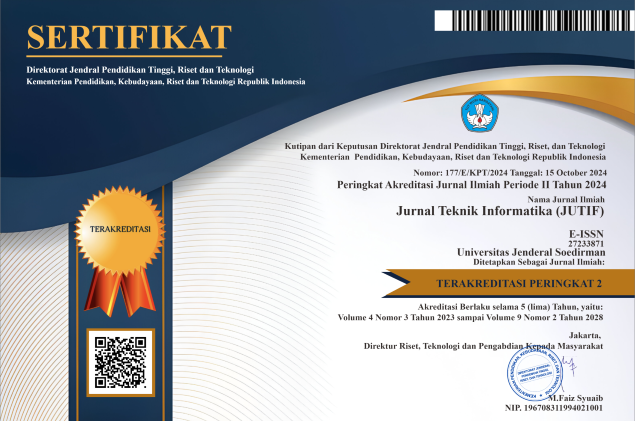IMPLEMENTATION OF THE RANDOM FOREST METHOD FOR CLASSIFYING LUNG X-RAY IMAGE ABNORMALITIES
DOI:
https://doi.org/10.52436/1.jutif.2025.6.1.4323Keywords:
COVID-19, X-ray Image, Random Forest, Classification, Cross-validationAbstract
The Covid-19 pandemic has caused a severe global health crisis. Rapid and accurate diagnostics are essential in combating this disease. In this regard, lung X-ray images have become critical for identifying Covid-19 infections. The method used in this study is random forest, a classification method based on ensemble modeling of decision trees. The lung X-ray images used in this study were taken from a datasheet containing images from COVID-19 patients and images from non-Covid-19 patients. The data pre-processing process involves extracting features from the images using image processing techniques and statistical analysis. The random forest model is trained using the processed datasheet to classify the lung X-ray images. The model's performance is evaluated using accuracy, sensitivity, and specificity metrics. In addition, cross-validation is used to measure the reliability and generalization of the model. The study results showed that the random forest method achieved good classification performance in distinguishing COVID-19 lung X-ray images from normal ones. The resulting model provided high accuracy and good sensitivity in identifying Covid-19 cases. These results show the potential of the random forest method in supporting early diagnosis and treatment of COVID-19 disease.
Downloads
References
M. Moitra, M. Alafeef, A. Narasimhan, V. Kakaria, P. Moitra, and D. Pan, “Diagnosis of COVID-19 with simultaneous accurate prediction of cardiac abnormalities from chest computed tomographic images,” PLoS One, vol. 18, no. 12 December, pp. 1–20, 2023, doi: 10.1371/journal.pone.0290494.
R. Supriyanti et al., “Support vector machine method for classifying severity of Alzheimer’s based on hippocampus object using magnetic resonance imaging modalities,” Int. J. Electr. Comput. Eng., vol. 14, no. 6, pp. 6322–6331, 2024, doi: 10.11591/ijece.v14i6.pp6322-6331.
R. Supriyanti, S. L. Dzihniza, M. Alqaaf, M. R. Kurniawan, Y. Ramadhani, and H. B. Widodo, “Morphological features of lung white spots based on the Otsu and Phansalkar thresholding method,” Indones. J. Electr. Eng. Comput. Sci., vol. 33, no. 1, pp. 530–539, 2024, doi: 10.11591/ijeecs.v33.i1.pp530-539.
R. Supriyanti, A. S. Aryanto, M. I. Akbar, E. Sutrisna, and M. Alqaaf, “The effect of features combination on coloscopy images of cervical cancer using the support vector machine method,” IAES Int. J. Artif. Intell., vol. 13, no. 3, pp. 2614–2622, 2024, doi: 10.11591/ijai.v13.i3.pp2614-2622.
R. Supriyanti, Y. Ramadhani, and E. Wahyudi, “Hippocampus’s volume calculation on coronal slice’s for strengthening the diagnosis of Alzheimer’s,” Telkomnika (Telecommunication Comput. Electron. Control., vol. 21, no. 1, pp. 123–132, 2023, doi: 10.12928/TELKOMNIKA.v21i1.20746.
R. Supriyanti, A. S. Aryanto, M. I. Akbar, and E. Sutrisna, “The Effect Of Combining Features On Detection Of Pre-Cervical Cancer Based On Colposcopy Images Using The Support Vector Machine Method,” in the 6 International Conference of Multidisciplinary Approaches for Sustainable Rural Development (ICMA-SURE), 2023.
R. Supriyanti, F. F. R. Wibowo, Y. Ramadhani, and H. B. Widodo, “Comparison of conventional edge detection methods performance in lung segmentation of COVID19 patients,” AIP Conf. Proc., vol. 2482, no. February, 2023, doi: 10.1063/5.0111683.
R. Supriyanti, E. Wahyudi, and Y. Ramadhani, “Simple tool for three-dimensional reconstruction of coronal hippocampus slice using matlab,” AIP Conf. Proc., vol. 2482, no. February, 2023, doi: 10.1063/5.0114412.
R. F. W. Supriyanti;, Y. Ramadhani;, and H. B. Widodo, “Comparison of conventional edge detection methods performance in lung segmentation of COVID19 patients,” AIP Conf. Proc., vol. 2482, no. 1, 2021.
R. Supriyanti, G. P. Satrio, Y. Ramadhani, and W. Siswandari, “Contour Detection of Leukocyte Cell Nucleus Using Morphological Image,” in Journal of Physics: Conference Series, Apr. 2017, vol. 824, no. 1. doi: 10.1088/1742-6596/824/1/012069.
R. Supriyanti, S. A. Priyono, E. Murdyantoro, and H. B. Widodo, “Histogram equalization for improving quality of low-resolution ultrasonography images,” Telkomnika (Telecommunication Comput. Electron. Control., vol. 15, no. 3, pp. 1397–1408, 2017, doi: 10.12928/TELKOMNIKA.v15i3.5537.
R. Supriyanti, A. A. Hafidh, Y. Ramadhani, and H. B. Widodo, “MEASURING GESTATIONAL AGE AND UTERINE DIAMETER BASED ON IMAGE SEGMENTATION,” ARPN J. Eng. Appl. Sci., vol. 13, no. 2, 2018, [Online]. Available: www.arpnjournals.com
R. Supriyanti, A. Chrisanty, Y. Ramadhani, and W. Siswandari, “Computer aided diagnosis for screening the shape and size of leukocyte cell nucleus based on morphological image,” Int. J. Electr. Comput. Eng., vol. 8, no. 1, pp. 150–158, Feb. 2018, doi: 10.11591/ijece.v8i1.pp150-158.
R. Supriyanti, A. Rahmadian Subhi, Y. Ramadhani, and H. B. Widodo, “A Simple Tool for Identifying the Severity of Alzheimer’s Based on Hippocampal and Ventricular Size Using a Roc Curve on a Coronal Slice Image,” Asian J. Inf. Technol., vol. 17, no. 7, 2018.
B. J. Saleh, Z. Omar, V. Bhateja, and L. I. Izhar, “Auto-Lesion Segmentation with a Novel Intensity Dark Channel Prior for COVID-19 Detection,” J. Phys. Conf. Ser., vol. 2622, no. 1, pp. 1–9, 2023, doi: 10.1088/1742-6596/2622/1/012002.
V. K. Prasad, D. Dansana, S. G. K. Patro, A. O. Salau, D. Yadav, and M. Bhavsar, “CIA-CVD: cloud based image analysis for COVID-19 vaccination distribution,” J. Cloud Comput., vol. 12, no. 1, 2023, doi: 10.1186/s13677-023-00539-y.
R. Supriyanti, M. R. Kurniawan, Y. Ramadhani, and H. B. Widodo, “Calculating the area of white spots on the lungs of patients with COVID-19 using the Sauvola thresholding method,” Int. J. Electr. Comput. Eng., vol. 13, no. 1, pp. 315–324, 2023, doi: 10.11591/ijece.v13i1.pp315-324.
H. X. Stubblefield J, Causey J, Dale D, Qualls J, Bellis E, Fowler J, Walker K, “COVID19 Diagnosis Using Chest X-rays and Transfer Learning,” medRxiv [Preprint], vol. 10, no. 09, p. 22280877, 2022, doi: 10.1101/2022.10.09.22280877.
B. Modi et al., “Analysis of Vocal Signatures of COVID-19 in Cough Sounds: A Newer Diagnostic Approach Using Artificial Intelligence,” Cureus, vol. 16, no. 3, pp. 1–12, 2024, doi: 10.7759/cureus.56412.
H. Salarabadi, M. S. Iraji, M. Salimi, and M. Zoberi, “Improved COVID-19 Diagnosis Using a Hybrid Transfer Learning Model with Fuzzy Edge Detection on CT Scan Images,” Adv. Fuzzy Syst., vol. 2024, 2024, doi: 10.1155/2024/3249929.
M. K. Bohmrah and H. Kaur, “Multiclass Chest Disease Classification Using Deep CNNs with Bayesian Optimization,” Int. J. Adv. Comput. Sci. Appl., vol. 15, no. 8, pp. 1285–1300, 2024, doi: 10.14569/IJACSA.2024.01508125.
S. Antar, H. K. H. Abd El-Sattar, M. H. Abd-Rahman, and F. F. M. Ghaleb, “COVID-19 infection segmentation using hybrid deep learning and image processing techniques,” Sci. Rep., vol. 13, no. 1, pp. 1–18, 2023, doi: 10.1038/s41598-023-49337-1.
S. Rojas-Zumbado et al., “Upper body thermal images and associated clinical data from a pilot cohort study of COVID-19,” BMC Res. Notes, vol. 17, no. 1, pp. 1–5, 2024, doi: 10.1186/s13104-024-06688-w.
M. R. Naidji and Z. Elberrichi, “A Novel Hybrid Vision Transformer CNN for COVID-19 Detection from ECG Images,” Computers, vol. 13, no. 5, 2024, doi: 10.3390/computers13050109.
R. C. Gonzales and R. . Woods, Digital image processing, 3rd ed. New Jersey: Prentice Hall, 2008.
J. Liu, Y., Wang, Y., Zhang, “New Machine Learning Algorithm: Random Forest,” Inf. Comput. Appl., vol. 7473, 2012, doi: https://doi.org/10.1007/978-3-642-34062-8_32.


























